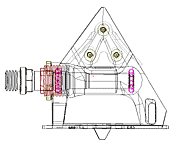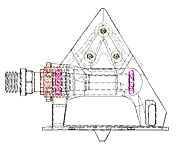3D ACIS PHL V5
Though 3D is now the de facto CAD standard in most engineering disciplines, 2D still has a place in industries such as technical illustration, manufacturing, and architecture. Because 3D models are the typical primary output for CAD design, users in these industries require an efficient and accurate method of generating 2D computational drawings directly from the 3D models. Hidden line removal (HLR) is an important aspect of creating an accurate 2D representation from a 3D model. Using HLR, the converted model only displays those parts visible from a given perspective; hidden (or occluded) edges normally included in a 3D model representation are removed, or drawn in a line style that indicates their obscured position.
Fast, Accurate, and Reliable HLR Computation
3D ACIS® PHL V5 is an HLR solution from Spatial based on CATIA V5 technology. 3D ACIS PHL V5 is an ACIS-dependent development technology - an ACIS license is required. The proven, industrial-strength CATIA V5 technology used in ACIS PHL V5 and developed by Dassault Systèmes has built its reputation for accuracy and speed through heavy use by respected engineering firms under the most demanding conditions.
To add a measure of control, ACIS PHL V5 also allows users to customize the level of hidden line resolution calculations to match the accuracy required by their specific applications. The combination of performance, reliability, and precision delivered by ACIS PHL V5 make it an excellent choice for CAD, CAM, technical illustration, or any modeling or viewing application that needs to generate hidden line or planar projectable views of ACIS models.

Figure. PHL V5: Wireframe Display of a 3D Model

Figure. PHL V5: Dashed Hidden Line Display of a 3D Model

Figure. PHL V5: Hidden Line Removal of a 3D Model
Model designed by a student of Professor Mathieu Laruelle, Lycee d'Enseignement Industriel
ACIS PHL V5 Functionality
Edge Classification
Applications use this information to determine which lines and line styles to
draw. ACIS PHL V5 analyzes ACIS surface and solid models and classifies all
edges and silhouettes into the following designations:
- Visible - Lines that are unobstructed and visible from the current perspective; for example, the front edges of a cube are visible.
- Hidden - Edges that are hidden by material in the current perspective; for example, in a slightly nonorthogonal view of a cube, edges along the rear side of the shape.
- Occluded - Edges that are obscured by another edge. For example, in a 45-degree view of a cube, the front vertical edge occludes the rear vertical edge. When viewing a visible edge (solid line) overlaying an occluded edge (dashed line), the visual confusion is reduced by removing the occluded line.
Exact or Polyline Edge B-Rep
- Curve Representation - ACIS PHL V5 provides two curve representations for drawing a model with HLR. For applications that need the exact curve representation, a pointer to the model data accesses the geometry of the edge. ACIS PHL V5 also provides a polyline approximation of the curve for applications that do not require this level of precision.
- Thickening/thinning - ACIS PHL V5 has the ability to identify exterior edges on the model and display them as "thick" or interior lines as "thin," as well as adjusting line thickness where visual convexity changes. This helps to increase the perceived depth of a model's hidden line representation. This is excellent for technical illustration and other viewing applications.
- Smoothing - Contour lines created by changes in the 3D model's surface are often irrelevant in 2D drawings, and may be eliminated using this function.
Adjustable Levels of Accuracy
For ease of use, ACIS PHL V5 automatically calibrates the accuracy of the hidden line calculations based on model extents. This accuracy can be manually overridden by users who need to control how closely the hidden line removal view matches the model's precise curve and surface data.
For more information and a PHL V5 example, refer to the section 3D ACIS PHL V5.
[Top]
© 1989-2007 Spatial Corp., a Dassault Systèmes company. All rights reserved.